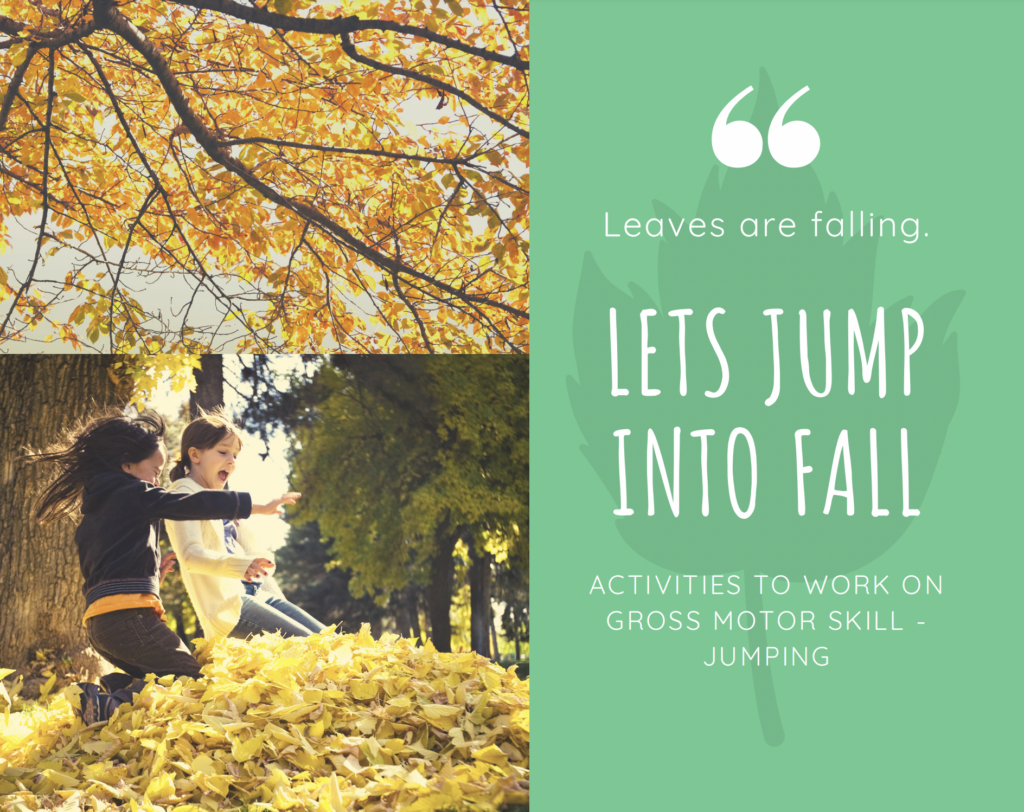
Jumping with a two footed takeoff and landing is a gross motor milestone that is typically seen around two years of age for typically developing children and will begin by jumping in place. Jumping requires leg strength, motor coordination and planning, and balance. Once your child starts to clear the floor, there are lots of different ways to jump! You can jump forward, backwards, and side to side. You can jump over, onto, or down from objects as well! Here are some examples and progressions of how to get your little one jumping.
Ways to work on jumping:
Squats: This step helps your little one to gain leg strength and confidence needed for take-off!
- From standing, squat down to pick up objects and then stand back up
- Blastoff jumps – start squatting low to ground and then jump up super fast!
- Squat to stand with weight shift onto toes reaching to grab toys overhead
Bouncing: Bouncing by bending knees quickly in standing helps to develop coordination and change in direction
- Music and “dancing” up and down can be a fun way to incorporate this bouncing movement
- Hold your child’s hands to encourage bending and straightening of their knees
- Use of cushions on the floor, trampolines, or mattress to bounce on
Jumping Up: Jumping up with foot clearance is first and then progression is jumping up with a toy to reach and grab for
- Jumping to pop bubbles, cushions on floor, trampoline
- Use of hands or furniture nearby to encourage vertical jumps with hands supported
- Jumping to reach a toy or ball out of your hands
- Jumping up for a high five or fist bump
Jumping Down: This is great to practice jumping off a sidewalk curb or bottom step at home!
- Start with the low step and increase height as your child progresses
- Assist at the hands or hips, and use words such as “jump” or “bend” to help with timing of the movement
- They may need extra help to “stick” the landing at first to improve confidence with the skill.
Jumping Forward: At first, they may fall with the push-off or landing and may land with staggered feet as if they are galloping. This will improve with practice as they fine tune the skill!
- Jumping into a pile of leaves – leaves or other visual targets can assist with a forward jump
- Use of a sack or a bag can also help to keep feet together – stay close by since this may limit them from catching themselves if they fall!
Jumping Over: Start with long narrow objects first!
- Jumping over a line drawn out with chalk outside, or tape on the floor
- Use of visual aids, such as color dots or footprints on the floor help for your child to see where their jumping target is
- Progress with jumps over foam noodles or hula hoops on the floor, or puddles outside
- Increase in level of difficulty with change of direction – side to side, forward, or backwards
Jumping Onto: This step can be intimidating at first! Start with objects low to the ground to build confidence and progress accordingly.
- Start by jumping up in place and bring knees towards chest
- Start with short height steps or stools and progress – make sure they are stable to jump onto
- Motor coordination and planning with arm swings can help with the momentum to increase height of jump
Higher Level Jumping Activities:
- Jumping Rope
- Hopscotch
- Arrow Jumping Game
- Jumping Obstacle Courses
Aside from playing jumping games with your little one, spending plenty of time outside, at playgrounds, and with peers and siblings, will help motivate them to practice this fun and valuable skill!
Happy Jumping!
Your child and family will flourish with the support of our team. You're not alone in your child's growth and development journey.
looking for answers to your questions and concerns?
You’re in the right place.
Contact
Resources
Therapists
Services
About
Joyfully serving infants & children in Hiawatha, Cedar Rapids, Marion, and surrounding Iowa communities
Patient Forms
designed by Melissa Meis
privacy policy
all rights reserved
1717 Boyson Rd, Hiawatha, IA 52233 | (319) 200-2004
Email: info@proactivepediatrictherapy.com